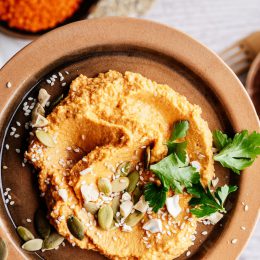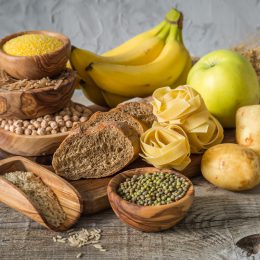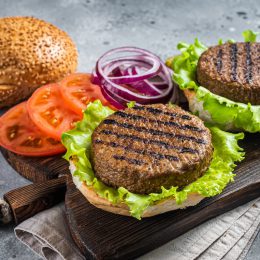8 Common Nutrition Myths—Busted!
A registered dietitian shares the myths about nutrition and eating that you shouldn’t believe.

The best way to eat healthy is a hotly contested topic, and unfortunately the internet is full of misinformation. It can be confusing to tell what’s true and what isn’t, and false theories that were previously passed through word-of-mouth now spread like wildfire on social media.
Popular nutrition myths can impact your food choices and make eating healthfully seem harder than it needs to be. You’ve likely heard most of these common food and nutrition misconceptions repeated at one time or another. Let’s set the record straight.
Healthy eating and fitness go together! SilverSneakers classes and events are happening right now at participating gyms, online through SilverSneakers LIVE, and at community centers near you. Activate your free online account to get started.
Myth #1: Fat-Free or Low-Fat Is Better Than Full Fat
Fat was once the villain, but nutrition experts have rethought that idea. When you avoid eating fat, you miss out on foods that help keep you feeling full. Plus, low-fat foods can backfire: They often are high in sugar and sodium to make up for the lack of texture and flavor that happens when fat is removed from food. So, they’re not necessarily healthier, and they may not save you any calories either.
Peanut butter is a good example. Many reduced-fat versions of this nut butter replace some of the healthy unsaturated fat found in peanuts with not-so-healthy sugar. Fat-free salad dressing is problematic too. It won’t increase your absorption of important fat-soluble nutrients and antioxidants like vitamin K and beta-carotene that are found in the vegetables in your salad. And an argument can be made that it’s better to enjoy a plain version of full-fat yogurt instead of the same amount of a high-sugar, fat-free one. Recent research is questioning the link between dairy fat and heart disease, and there is mounting evidence that added sugar harms your health.
If you’ve avoided fat for years, it may be time to give it a try again. Be sure to read the nutrition label on food packages to see how the calories, sodium and sugar stack up between the non- or lower-fat and original versions.
Recommended reading: Should You Ditch Low-Fat Foods for Good?
The Healthiest High-Fat Foods, According to Dietitians
Myth #2: Fasting Is the Path to Weight Loss
Intermittent fasting is a popular eating pattern where you eat during a limited number of hours during the day—and eat nothing the rest of the time. It’s promoted as a better way to drop pounds than cutting back on total daily calories. But it’s effect on weight loss is smaller than you would think.
Studies show that intermittent calorie restriction doesn’t necessarily lead to more weight loss than a diet where you eat when you want to—as long as your calorie intake is controlled to a level that promotes a drop in body weight. For the most part, calories are calories no matter when you eat them.
There is more than one way to eat for a slimmer body, and skipping meals isn’t necessary. What’s most important is that you determine what your overall calorie intake should be to achieve and maintain a healthy body weight.
Recommended reading: 6 Questions to Ask Yourself Before Jumping Into a New Diet
Myth #3: Natural Sweeteners Are Healthier Than Sugar
Most so-called “natural sweeteners” like honey, maple syrup, and coconut sugar are marketed as being more nutritious than high fructose corn syrup and white sugar. This leaves people thinking they can use more of it without the health risks.
That isn’t true: The nutritional difference between these sweeteners is less than you want it to be.
Sweeteners like honey and maple syrup do contain some nutrients and antioxidants, but not enough to contribute to your nutritional needs. Unless you consume large amounts, which would be a bad idea. Honey and maple syrup contain slightly more calories than granulated sugars. Honey has 64 calories in a tablespoon serving, maple syrup has 52, and white sugar has 49. And their impact on your health may be very similar.
One study in the Journal of Nutrition discovered that when consumed in the same amounts, honey, high fructose corn syrup, and regular sugar can result in the same detrimental metabolic effects that may raise heart disease risk.
All sweeteners should be used with restraint. Use just enough to add a touch of sweetness to foods, but not so much where it becomes problematic. Make it a goal to limit all added sweeteners in your diet instead of just zeroing in on the ones that get the worst publicity.
Myth #4: White Poultry Meat Is Better for You Than Dark Meat
This idea is completely without merit. What gives dark chicken or turkey meat their darker appearance is the presence of high amounts of a protein called myoglobin, which provides oxygen to your muscles. Since chickens and turkeys walk and don’t fly, their thigh meat is saturated with myoglobin. The breast meat is paler due to lower levels of this compound.
Ounce for ounce, white meat like chicken breasts has nearly the same calories and just one fewer gram of fat as chicken thighs. Hardly worth losing sleep over. Dark meat also contains just as much protein and even more zinc, iron, and B vitamins. Plus, you get the extra juicy taste and a lower price.
One caveat though: Remove the skin after cooking, since it contains a significant amount of unhealthy saturated fat.
Myth #5: Eating More Often Boosts Metabolism
Unfortunately for grazers who want to lose weight, there is little scientific evidence that this is true. Yes, there is a temporary uptick in your metabolic rate when your body is digesting and processing food. But it’s not enough to have much of an impact on body weight. The evidence shows that given an equal amount of daily calories, the number of meals makes no significant difference in fat loss.
In other words, how often you eat has less effect on your weight than your total daily calorie intake. For some, spreading meals and snacks throughout the day reduces hunger and overeating. If that’s the case for you, it is a good idea to eat this way. But if you are someone who has a hard time with portion control, eating less frequently may make it easier for you to eat less.
Myth #6: Gluten Is Bad News
Everyone seems to be beating up on gluten these days. So what is it? Gluten is a protein found in grains like wheat, rye, and barley, and it is found in many different foods like breads and pasta.
Many people blame gluten for inflammation, digestive problems, brain fog, and a host of other ills. But many people who avoid it don’t need to be. Research in the journal Digestion found that among people who believed they were sensitive to gluten, 86% could eat it just fine without health issues.
Unless you have celiac disease, which is an illness caused by an immune reaction to eating gluten—or a diagnosed non-celiac gluten sensitivity—you can continue to cook and eat foods that contain gluten, such as your whole-grain morning toast.
If you unnecessarily replace all your conventional bread, pasta, and baked goods with gluten-free alternatives, you’d see a spike in your grocery bill without doing much to improve the nutritional quality of your diet. Many packaged gluten-free products are less nutritious, not more.
Myth #7: Plant-Based Milk Is Healthier Than Dairy Milk
There are dozens of different milk options available out there — from regular old cow’s milk to soy, pea, oat, almond, and seemingly everything in between. (Learn more about five common types of milk here.)
Subscribe to our newsletter
It's quick and easy. You could be one of the 13 million people who are eligible.
Already a member? Click to discover our 15,000+ participating locations.
Follow Us
Often, plant-based milks are touted as healthier options, but this is rarely the case. Except for soy and pea, plant-based milks rarely contain anywhere close to the amount of protein found in dairy milk.
For instance, a cup of almond milk has only a single gram of protein compared to the 8 grams in cow’s milk. Also, many plant-based milks don’t contain important nutrients like vitamin D, vitamin B12, and calcium you get from dairy milk. Some producers fortify their plant milk with those nutrients. But plant-based milks, if they’re not marked “unsweetened,” can also have troubling amounts of added sugar.
Despite what you may have heard, there is little evidence to show that consuming dairy can cause inflammation or heart disease. Ultimately, the milk you choose comes down to personal choice. Plant-based milks are a good option for those who are lactose intolerant or who eat a plant-only diet. But they are largely undeserving of their health halo, and you’ll need to consume more protein and nutrients elsewhere in your meals.
Recommended reading: How to Start Eating Plant-Based: The SilverSneakers Guide
Myth #8: Don’t Eat at Night
The popular idea is that if you eat after sunset, you’ll be more likely to gain weight and ruin your sleep. But eating food late at night does not make your body store more fat—unless you are consuming more calories than you’ve burned for the day.
It’s fairly simple math: If you have already met your caloric needs then, yes, the calories you consume later in the day can make you gain weight.
Here are the real problems with late-night eating:
- You may choose less healthy foods at this time, like chips, ice cream, and baked goods.
- You may be eating emotionally or mindlessly, and not because you’re hungry.
As for messing with your sleep, there isn’t much research to prove that. We all likely have individual responses to this. Some people may be able to eat a big bowl of food at night and still quickly zonk out, while others need more digestion time to sleep well. If you decide to eat at night, it’s important to make healthier choices and not mindlessly snack in front of the television.
See our sources:
Link between dairy fat and heart disease; harmful health effects of added sugar: European Heart Journal
Study on heart disease risk and natural sweeteners, high fructose corn syrup, and regular sugar: Journal of Nutrition
Study on meal frequency and fat loss: American Journal of Clinical Nutrition
Research on gluten sensitivity symptoms: Digestion
Check Your SilverSneakers Eligibility Instantly
SilverSneakers members can go to thousands of nationwide gyms and fitness locations, plus take SilverSneakers LIVE online classes that are designed for all fitness levels and abilities. If you have a Medicare Advantage plan, it may include SilverSneakers — at no additional cost. Check your eligibility instantly here.
Already a member? Get your SilverSneakers member ID and exclusive fitness and wellness content by activating your online account here.
Not eligible for SilverSneakers? You can still get 200+ free SilverSneakers On-Demand videos and stay in touch with us by creating your online account.





